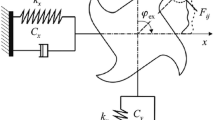Abstract
This paper describes the use of the grinding force signal to show the mechanical noise reduction and to detect the dressing time based on the discrete wavelet decomposition. As a result of de-noising, the wavelet de-noising method was more effective than the FFT filtering technique. From the approximation coefficients of the higher order wavelet transform, the grinding force signal obtained by a tool dynamometer was clear so it was possible to successfully detect the dressing time. A measured result by the surface roughness and the ground surface photograph coincided with the detection result.









Similar content being viewed by others
References
Wang YW, Moon KS (1997) A methodology for the multi-resolution simulation of grinding wheel surface. Wear 211(11):218–225
Kwak JS, Song JB (2001) Trouble diagnosis of the grinding process by using acoustic emission signals. Int J Mach Tools Manuf 41(3):899–913
Jiang XQ, Blunt L, Stout KJ (2001) Application of the lifting wavelet to rough surface. Precis Eng 25(2):83–89
Lin J (2001) Feature extraction of machine sound using wavelet and its application in fault diagnosis. MDT & E Int 34(1):25–30
Lee BY, Tarng YS (2000) Drill facture detection by the discrete wavelet transform. J Mater Process Technol 99(3):250–254
Kim JD, Kang YH, J DX, Lee YS (1997) Development of discontinuous grinding wheel with multi-porous grooves. Int J Mach Tools Manuf 37(11):1611–1624
Yamguchi K, Horaguchi I, Sato Y (1998) Grinding with directionally aligned SiC whisker wheel-loading free grinding. Precis Eng 22(2):59–65
Zhang C, Shin YC (2002) A novel laser-assisted truing and dressing technique for vitrified CBN wheels. Int J Mach Tools Manuf 42(7):825–835
Lim HS, Fathima K, Kumar AS, Rahman M (2002) A fundamental study on the mechanism of electrolytic in-process dressing (ELID) grinding. Int J Mach Tools Manuf 42(8):935–843
Author information
Authors and Affiliations
Corresponding author
Rights and permissions
About this article
Cite this article
Kwak, JS., Ha, MK. Detection of dressing time using the grinding force signal based on the discrete wavelet decomposition. Int J Adv Manuf Technol 23, 87–92 (2004). https://doi.org/10.1007/s00170-003-1556-7
Received:
Accepted:
Published:
Issue Date:
DOI: https://doi.org/10.1007/s00170-003-1556-7



